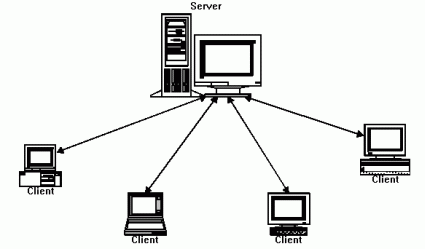Two types of Network Architecture:
- Peer-to-Peer Model
- Client-server Model
Peer-to-Peer Model:
In a peer-to-peer network, networked computers act as equal partners, or peers. As peers, each computer can take on the client function or the server function. Computer A may request a file from Computer B, which then sends the file to Computer A. Computer A acts like the client and Computer B acts like the server. At a later time, Computers A and B can reverse roles.

In a peer-to-peer network, individual users control their own resources. The users may decide to share certain files with other users. The users may also require passwords before they allow others to access their resources. Since individual users make these decisions, there is no central point of control or administration in the network. In addition, individual users must back up their own systems to be able to recover from data loss in case of failures. When a computer acts as a server, the user of that machine may experience the reduced performance as the machine serves the requests made by other systems.
As networks grow, peer-to-peer relationships become increasingly difficult to coordinate. A peer-to-peer network works well with ten or fewer computers. Since peer-to-peer networks do not scale well, their efficiency decreases rapidly as the number of computers on the network increases. Also, individual users control access to the resources on their computers, which means security may be difficult to maintain. The client/server model of networking can be used to overcome the limitations of the peer-to-peer network.
Peer-to-peer networks are relatively easy to install and operate. No additional equipment is necessary beyond a suitable operating system installed on each computer. Since users control their own resources, no dedicated administrators are needed.
The advantages of peer-to-peer:
- No need for a network administrator
- Network is fast/inexpensive to setup & maintain
- Each PC can make backup copies of its data to other PCs for security.
- Easiest type of network to build, peer-to-peer is perfect for both home and office use.
Client-server Model:
The term client-server refers to a popular model for computer networking that utilizes client and server devices each designed for specific purposes. The client-server model can be used on the Internet as well as local area networks (LANs). Examples of client-server systems on the Internet include Web browsers and Web servers, FTP clients and servers, and DNS.
In a client/server arrangement, network services are located on a dedicated computer called a server. The server responds to the requests of clients. The server is a central computer that is continuously available to respond to requests from clients for file, print, application, and other services. Most network operating systems adopt the form of a client/server relationship. Typically, desktop computers function as clients and one or more computers with additional processing power, memory, and specialized software function as servers.

Servers are designed to handle requests from many clients simultaneously. Before a client can access the server resources, the client must be identified and be authorized to use the resource. Each client is assigned an account name and password that is verified by an authentication service. The authentication service guards access to the network. With the centralization of user accounts, security, and access control, server-based networks simplify the administration of large networks.
The concentration of network resources such as files, printers, and applications on servers also makes it easier to back up and maintain the data. Resources can be located on specialized, dedicated servers for easier access. Most client/server systems also include ways to enhance the network with new services that extend the usefulness of the network.
The centralized functions in a client/server network have substantial advantages and some disadvantages. Although a centralized server enhances security, ease of access, and control, it introduces a single point of failure into the network. Without an operational server, the network cannot function at all. Servers require a trained, expert staff member to administer and maintain. Server systems also require additional hardware and specialized software that adds to the cost.
Client/server describes the relationship between two computer programs in which one program, the client, makes a service request from another program, the server, which fulfills the request. Although programs within a single computer can use the client/server idea, it is a more important idea in a network. In a network, the client/server model provides a convenient way to interconnect programs that are distributed efficiently across different locations. Computer transactions using the client/server model are very common. For example, to check your bank account from your computer, a client program in your computer forwards your request to a server program at the bank. That program might in turn forward the request to its own client program that sends a request to a database server at another bank computer to retrieve your account balance. The balance is returned back to the bank data client, which in turn serves it back to the client on your personal computer, which displays the information for you.
Advantages:
- Flexibility of the system,
- scalability,
- cost saving, centralized control and implementation of business rules,
- increase of developer's productivity,
- portability,
- improved network, and
- resource utilization.